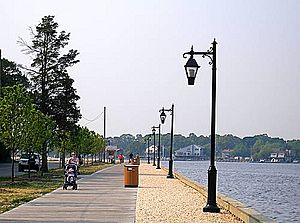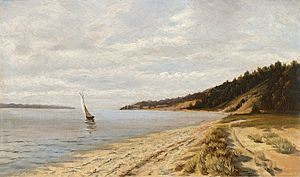Toms River facts for kids
The Toms River is a 41.7-mile (67.1 km) long freshwater river and estuary located in Ocean County, New Jersey. An estuary is where a river meets the sea, mixing fresh and salt water. This river is an important part of the local environment and community.
Contents
About the Toms River
Where the River Flows
The Toms River begins in the Pine Barrens area of northern Ocean County. It flows southeast and then east, winding its way through wetland areas. Many smaller streams join the river along its path. Finally, it empties into Barnegat Bay, which is an inlet of the Atlantic Ocean.
The last 5 miles (8 km) of the river are a wide tidal estuary. This part of the river is deep enough for boats and is located near the town of Toms River.
Fun Things to Do
The lower part of the Toms River is a great place for many activities. You can find marinas and yacht clubs there, which are perfect for boating. It's also an excellent spot for fishing and crabbing. Many people enjoy canoeing and kayaking on the river. You can paddle for about 21.7 miles (34.9 km) from Don Connor Boulevard all the way to Barnegat Bay.
How the River Got Its Name
Before the early 1700s, the Toms River was known as Goose Creek. It was renamed in the early 18th century. There are a few ideas about where the new name came from. It might have been named after an English captain named William Toms, a farmer and ferryman named Thomas Luker, or even a Native American person named Tom. The name was first written as Tom's River and later changed to Toms River. The town that grew up along the river in 1712 also took the same name.
Keeping the River Clean
In the 1960s, people discovered that the lower part of the river had been affected by pollution from a factory that made dyes. This led to concerns about the health of people living nearby. Since then, a lot of effort has gone into cleaning up the river. Groups of people and organizations have worked together to restore the river and protect the wetland areas where it starts in the Pinelands. These efforts have helped to improve the water quality in the Toms River. A book called Toms River: A Story of Science and Salvation looked closely at the river's environmental story.
River Branches
- Union Branch




